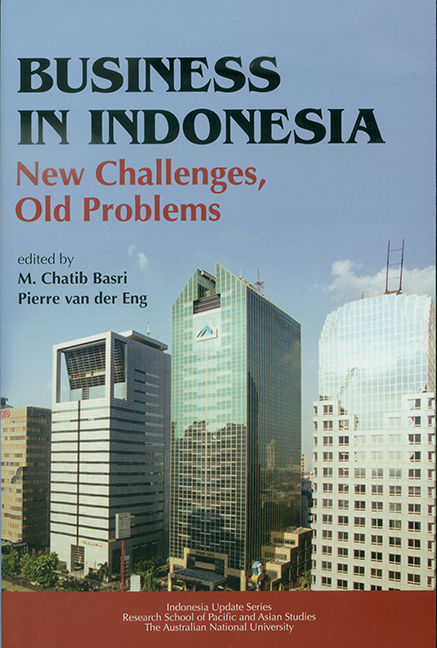Book contents
- Frontmatter
- Contents
- Tables
- Figures
- Contributors
- Acknowledgments
- Glossary
- 1 Business in Indonesia: Old Problems and New Challenges
- PART I Political and Economic Developments
- PART II Overview of the Business Environment
- PART III Foreign Investment and Trade
- 6 Recent Trends in Foreign Direct Investment
- 7 Exports by Small and Medium-Sized Enterprises in Indonesia
- PART IV Key Issues in the Business Environment
- References
- Index
- Indonesia Update Series
6 - Recent Trends in Foreign Direct Investment
from PART III - Foreign Investment and Trade
Published online by Cambridge University Press: 21 October 2015
- Frontmatter
- Contents
- Tables
- Figures
- Contributors
- Acknowledgments
- Glossary
- 1 Business in Indonesia: Old Problems and New Challenges
- PART I Political and Economic Developments
- PART II Overview of the Business Environment
- PART III Foreign Investment and Trade
- 6 Recent Trends in Foreign Direct Investment
- 7 Exports by Small and Medium-Sized Enterprises in Indonesia
- PART IV Key Issues in the Business Environment
- References
- Index
- Indonesia Update Series
Summary
The recovery in investment – both domestic and foreign – during the post-crisis period has been sluggish, partly explaining the relatively low economic growth rates in Indonesia since 2001. The consequences of this low-growth period have been slow employment creation in the formal/modern sector and rapid expansion in the informal/traditional sector. Higher rates of investment are required to shift Indonesia to a higher growth path. This chapter reviews recent trends in investment and discusses the factors that explain the sluggish recovery in foreign direct investment (FDI) in particular.
The next section reviews recent trends and the changing pattern of FDI. The third section touches briefly on the consequences of the slow recovery in investment, and the fourth discusses the obstacles to a recovery. This is followed by a brief discussion of the government's investment and employment strategy as outlined in its White Paper.
TRENDS IN INVESTMENT DURING THE POST-CRISIS PERIOD
As mentioned above, the recovery in both domestic and foreign investment has been sluggish during the post-crisis period. As demonstrated in Figure 6.1, real aggregate investment in the economy collapsed in 1998 and bottomed out in the second quarter of 1999 at half the pre-crisis peak investment levels. There was a sharp rebound in 2000, with investment climbing to 70 per cent of pre-crisis levels, but the recovery stagnated in 2001 and 2002. Investment picked up slightly at the end of 2002 and continued its modest recovery in the first semester of 2003. Consistent with aggregate investment in the economy, new FDI remains at historically low levels. Some foreign firms have closed their subsidiaries in Indonesia during the last few years, especially in footwear and other labour-intensive sectors.
- Type
- Chapter
- Information
- Business in IndonesiaNew Challenges, Old Problems, pp. 93 - 107Publisher: ISEAS–Yusof Ishak InstitutePrint publication year: 2004



